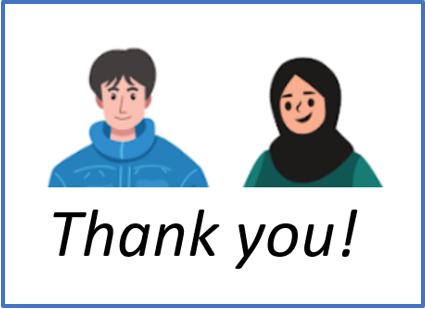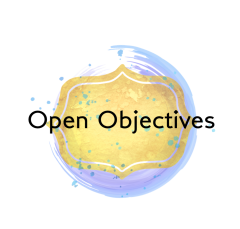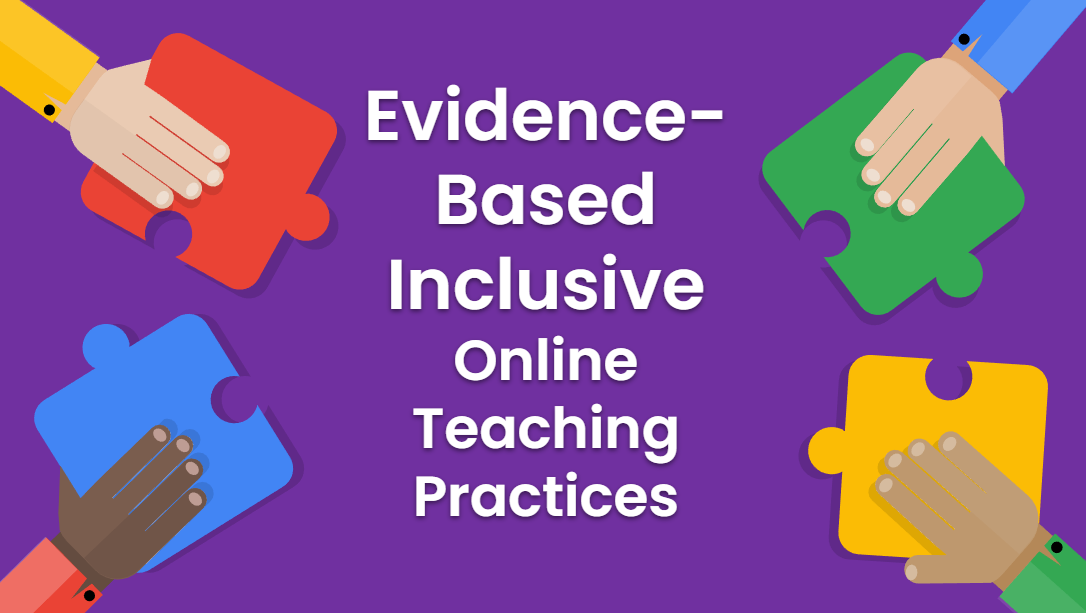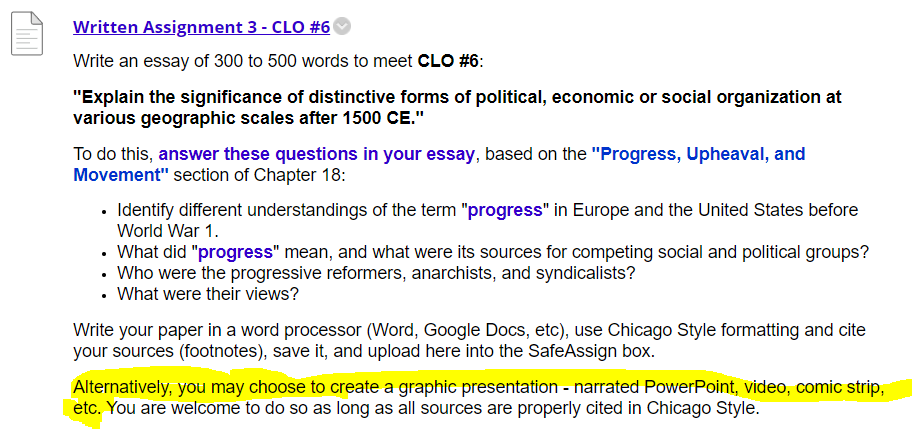Evidence-Based Inclusive Online Teaching Practices
This website contains information about evidence-based practices on:
A) how to structure the online course,
B) present the learning materials,
C) engage your students, and
D) assess learning outcome attainment by following Universal Design for Learning principles as well as best practices for active learning, equitable assessment, and metacognitive practices.
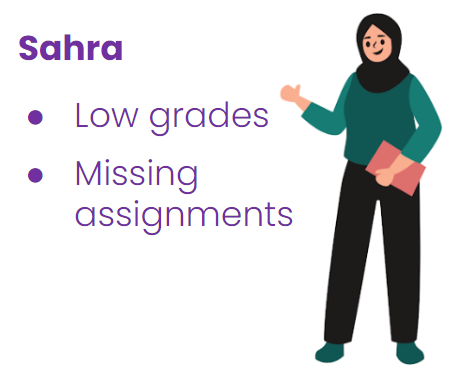
https://tinyurl.com/InclusiveJamboard – Comprehensive Jamboard
A – Structuring the Online Course
1 Create a Clearly designated course starting point.
Ensure students can successfully start your course and follow a clear path to the content they need by creating a straightforward “Start Here” module.
2 Use An Intuitive, accessible layout.
A well designed online course provides an intuitive and accessible course layout so that little cognitive effort is required to navigate and locate course content.
Simunich et. al (2015) and Placencia and Mujiana (2019) find that intuitive navigation schemes increase student motivation, self-efficacy, and perceptions of course quality.
Students learn more when their cognitive effort is devoted to learning course material rather than on course navigation.
3 Use consistent imagery and themes.
As noted above, simple course navigation allows students to focus on learning content rather than on course navigation.
The use of consistent imagery and themes in each course module reduces cognitive load by creating a familiar environment within each module.
4 Use integrated elements to create a clear learning path.
Embedding external content (such as YouTube videos or content provided by textbook publishers or other learning content providers) directly in the LMS is preferable to the use of links to the content since it improves accessibility and reduces the probability that students will be distracted by content on the external site.
Embedded external content also keeps the student’s focus within the LMS when they have finished viewing the content.
5 Use Consistent Assignment Structure and Rubrics.
When students begin a course, they are often unsure of the expectations that the instructors have for assignments in the course. They often discover these expectations only after receiving negative feedback on initial graded activities.
If these are high-stakes activities, it can be difficult to recover from incorrect guesses concerning instructor expectations.
Continuing-generation students graduating from well-funded secondary schools often arrive in college with some degree of preparation for the hidden curriculum of college.
First-gen students, especially those living in low-income communities, have less experience with the types of assignments that are expected of college students and can be at a significant disadvantage when instructor expectations are not clearly specified.
A growing body of research has found that providing students with more structure in assignments improves the performance of all students, but also reduces equity gaps that are related to race, gender, income, and first-gen status.
Eddy and Hogan (2014), for example, found that the introduction of additional structure in an introductory biology course cut the racial equity gap in half and eliminated the first-gen/continuing-gen gap. As noted by Allen and Tanner (2006), well designed rubrics make course expectations transparent for students (and instructors).
Additional structure can take the form of:
- Scaffolding larger assignments into a series of small lower-stakes tasks with feedback (and revision options) provided at each stage.
- Providing no-stakes or low-stakes practice exercises for topics that students may find challenging.
- More detailed descriptions of expectations, often provided using rubrics.
- Multiple exemplars of high-quality work.
- Use a workload estimator (such as that provided by Barre, Brown, and Esarey) to provide students with estimates of the time required to complete tasks to help students allocate sufficient time to complete their work.

B – Presenting the Learning Materials
1 Provide multiple means of representation of course content.
Students learn concepts more easily and recall them long term if the course content is relevant to their current and expected future lives.
One way of helping students connect to course content is through the Universal Design for Learning (UDL) principle of providing multiple means of representation.
Some students may connect to concepts more effectively through videos that illustrate course content while others may connect more easily through alternative narratives (in video, text, or other media).
Providing students with more ways of connecting to new concepts makes it easier for all students to integrate new knowledge into their cognitive models.
Sunyono and Meristin (2018) find that providing multiple means of representation was particularly beneficial for students that have less prior experience with the subject matter in Chemistry classes.
One component of UDL is that all course content meets accessibility standards. At a very minimal level, an inclusive course should never exclude students based on their disability status. This is also required by federal law.
Accessibility standards require that all images have alt tags that provide equivalent content, all videos have transcripts, that color contrast standards be met on all digital content, and that the reading order be specified in all documents .
Bangera and Brownell (2014) argue that undergraduate research projects can increase student engagement and serve as a tool to create a more inclusive environment by opening up the possibility of research to students in traditionally underrepresented groups that may not see themselves well represented among existing practitioners.
2 Implement inclusive materials created by diverse authors.
Faculty at most institutions are less diverse than student bodies. Robst and Russo (1998) have found that a lack of gender diversity in introductory STEM classes has a negative effect on female student retention in these fields.
The traditional canons in most academic disciplines do not generally reflect the culturally rich diversity of our students. The lack of cultural diversity in the faculty and in the readings in our courses can cause a sense of disconnection for many of our students.
There is some evidence that students are more likely to feel connected to an academic discipline if they see themselves and their interests as being reflected in the discipline.
Garth-McCullough (2008), for example, has found that including readings that include culturally bound prior knowledge from African-American experiences significantly increases student reading comprehension scores for African-American elementary school students.
Hajilari (2013) has found that the inclusion of culturally relevant examples increased student success in EFL classes offered in Iran.
These and other studies suggest that students learn more when they feel connected to the course content they are reading.
3 Include support resources for students with varied educational backgrounds.
Our students arrive in our classes with diverse prior educational backgrounds and experiences. This is especially true for students who were enrolled in middle school and high school during the pandemic.
Lichand et. al (2022) found that in Brazil students learning remotely during the pandemic experienced a 365% increase in dropout risk. Standardized test scores for Brazilian students indicated that students learned only 27.5% as much as when they received in-person instruction as they learned during in-person instruction. The decline in learning was especially large for low-income students.
The Education Recovery Scorecard based on NAEP data found that 3rd through 8th grade students in the U.S. lost the equivalent of a half year of math instruction and a quarter year of reading instruction during the pandemic.
The learning loss during the pandemic was not distributed equally. Students in the poorest 25% of school districts lost the equivalent of ⅔ of a year in math learning. The pandemic magnified the effect of the unequal distribution of educational resources across school districts. As noted by Weathers and Sosina (2022), segregation in housing patterns and local public school funding result in racial inequality in educational quality across school districts.
If students are to have equal opportunity of success, they must have easy access to the materials they need to be successful.
One strategy is to rely on the use of adaptive learning platforms that automatically provide students with support resources as needed.
Another is to include optional supplemental resources that can provide students with the resources that they need.
You can create your own supplemental resources or rely on the many resources that others have created and shared. YouTube, for example, can provide freely available instructional resources on just about any topic. Curating useful resources within our courses that are available where and when they are needed can help all of our students be successful.

C – Engaging Students
1 Create a Welcoming Syllabus.
The first contact that many students have with you and your course is through the course syllabus. An inclusive syllabus will: welcome students into your course, create a positive sense of course community, motivate student interest, describe the skills and knowledge students will gain by engaging with your class, and provide students with information about the activities and assessments that you have planned for them
Be mindful to use a positive tone when writing your course syllabus. Avoid writing the syllabus with a punitive or legalistic tone that describes a long series of “thou shalt nots.” Merchán et. al (2022) have found that student impressions of an online course are significantly related to the use of autonomous or controlling language in the course syllabus, with students reacting positively to language that indicates greater autonomy for the student in the course. Gurung and Galardi (2022) and Hamish and Bridges (2011) also note that the tone of the syllabus has a significant effect on student perceptions of and interactions with the instructor.
Many faculty members complain that students don’t read the syllabus. If students find the syllabus to be a helpful resource they are more likely to refer back to it when needed. Faculty often use a variety of activities such as a syllabus quiz, syllabus scavenger hunts, or small group discussion/review of the syllabus. An increasingly common practice is to allow students to ask clarifying questions directly in the syllabus using tools such as Hypothesis, Perusall, or the comment feature in Google docs. In any case, when students ask questions during the course, avoid the common “it’s in the syllabus” response. Students are navigating often very diverse course requirements in multiple courses and it’s easy to lose track of the requirements of each individual course.
2 Provide ways for students to get to know you.
The first contact that many students have with you and your course is through the course syllabus. Use this syllabus to welcome students into the course
Creating a course welcome video in which you introduce yourself can be an effective way of humanizing the instructor. This video can create a welcoming introduction to the class, to encourage students to reach out to you when they need assistance, and to create a positive sense of instructor presence. Your introductory video could be part of an introductory discussion forum in which you also ask students to post either text or video introductions.
Student impressions of you and the class environment can be formed quickly based on their initial impression of the class.
For in-person classes, Ambady and Rosenthal (1993) have shown that a very large share of variation in student course evaluations are formed in students’ first 30 seconds of exposure to the nonverbal behavior of the instructor.
Baker (2020) has shown that creating a strong sense of instructor immediacy and presence results in significant gains in student affective learning, cognition, and motivation.
3 Provide ways for students to get to know each other.
Many of the same techniques that you can use to help you get to know your students can also be used to help students get to know each other.
For example, introductory discussion forums can also be used to let students know each other.
Throughout the semester, low-stakes informal class discussion forums can also be used that encourage students to make connections between their lived experiences and course content.
Judie and John have both used low-stakes discussion forums, called either “Metacognitive Café” discussion forums or “Reflection” discussion forums to help students share information about their learning journeys and experiences that relate to course learning objectives.
In these discussions, students share information about the challenges they face and the strategies that they’ve used to address these challenges.
As part of these discussions, students often share information about their jobs, career goals, and other personal information that allow students to get to learn more about each other.
We have both found that the connections formed in these low-stakes discussion forums allow students to make more connections to the experiences of other students in later discussion forums.
Activities designed to help students get to know each other also allow you to learn more about your own students. Familiarity with your student circumstances engenders a sense of empathy and can improve communications when student work falls short of expectation.
When providing individual feedback to students, be sure to use their names. This small personal touch reminds students that you are treating them as unique individuals.
Small-group activities can also be used to help students to get to know other students. This is discussed below in section C5.
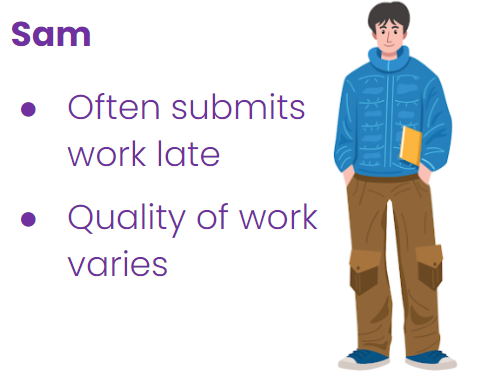
4 Include reflection Activities.
Reflection activities allow students to connect the course content to their lived experiences and future goals.
Intrinsic motivation for learning is increased when students see the relevance of the course content to their lived experiences and future goals.
As noted above, one method for doing this is to use low-stakes discussion forums in which students make and share such connections. Other approaches include the use of blog or journal tools located either within or outside of the LMS.
5 Provide a diversity statement.
A statement that recognizes differences as opportunities to enrich the educational environment for all learners.
Students from underrepresented groups often experience stereotype threat that can interfere with their learning.
Including a diversity statement in your course that treats diversity as an asset can help overcome stereotype threat, especially if this message is reinforced regularly throughout the course.
The use of activities in which students share their own connections to the learning material and see examples that are relevant to their own lives can also help to reinforce the value placed on diversity.

6 Provide opportunities for small group/Paired Activities.
Small group activities can help create a sense of class community, especially when the results of these activities are shared within the class.
In John’s introductory microeconomics class students create podcasts in groups of 2 or 3. (While the course is asynchronous, students have generally been able to find a time in which 2 or 3 students can work together. A discussion forum is used to help students form teams based on similar interests and time availability.)
In Judie’s history class students sign up to track specific topics throughout the semester and share resources with each other to support individual final projects at the end of the term.
7 Implement Active Learning Strategies.
Active learning involves student active participation and engagement in their learning, as opposed to the passive learning that occurs when a student quietly sits and listens to a lecture or reads a text.
The meta-analysis of Theobold et. al (2020) demonstrates that active learning results in increased student learning compared to passive learning. This study also finds that active learning significantly reduces the equity gap for underrepresented students on test scores by 33% and the gap in passing rates by 45%.
While the evidence supporting active learning is remarkably strong, Deslauriers et al (2019) found that students strongly prefer passive learning and believe that it is more conducive to learning, despite the improved learning outcomes achieved by those in classes that used active learning practices.
With passive learning, it is relatively easy for students to achieve fluency illusion, believing that they comprehend challenging course material when there is no evidence to the contrary in a passive learning environment.
Active learning, though, requires more cognitive involvement and provides more immediate feedback to students about misunderstandings and this can be a less pleasant experience. So, when adopting active learning techniques (in any modality), it is helpful to explain to students why you are doing so.
The use of small group or team projects discussed in the section above is one approach for including active learning activities in asynchronous online classes. There are also many other ways in which active learning activities can be introduced, for example:
- Using adaptive or personalized learning platforms in which students actively engage with course content as they learn it and receive personalized feedback as needed.
- Adding interactivity to short lecture videos using tools such as Camtasia, PlayPosit, or Edpuzzle that allow you to introduce questions or knowledge checks into multiple locations within a video.
- Having students actively engage with each other within texts using annotation tools such as Hypothesis or Perusall.
- Creating engaging discussion forums in which students are asked to connect course content to their lived experiences and/or to develop their critical thinking skills
- Using open pedagogy projects in which students serve as knowledge creators rather than passive consumers. Podcasts, instructional videos, wikis, infographics, and blogs are common examples of open pedagogy projects.
- Using open pedagogy projects in which students serve as knowledge creators rather than passive consumers. Podcasts, instructional videos, wikis, infographics, and blogs are common examples of open pedagogy projects.
- Using peer review projects (such as those described in Heffernan (2022).
8 Act on student feedback.
Regularly soliciting feedback from students sends a signal that you are concerned about their well being and success. In online classes this can be easily done using surveys in the LMS.
Receiving feedback from students, though, is not enough.
You should also be sure to respond to the feedback that your students have provided, incorporating suggestions where appropriate, but also providing them with explanations when some of their suggestions may not be appropriate to support their learning journeys.
If you are going to ask students to stretch outside of their comfort zone to try some new learning techniques (such as asking them to create instructional videos, podcasts, infographics, or TikToks, it’s important that you provide students with tutorial resources that will allow them to be successful.
It also helps if you can introduce new techniques using low-stakes activities that reduce anxiety.
For example, when John introduces a podcast project, he surveys students about their concerns. One concern that always occurs is that students are not sure if they have the skills and/or technology to record a podcast. To help students become more comfortable with this task, he provides students with instructions and asks students to listen to a podcast that they select (from a list of economic podcasts) and has them record and submit a brief audio response to the podcast they listened to. The successful completion of this task allows them to overcome their anxiety and focus on the construction of a podcast that demonstrates their learning.
As noted by Cavanagh (2019), the most effective treatment for overcoming anxiety is “controlled exposure in a safe setting.” (The construction of a safe environment is also, in general, an important part of creating an inclusive course.)
9 Maintain consistent communications.
Maintaining regular and substantive interactions with students is not only an evidence-based practice, it is also a federal requirement.
One aspect of this is providing a regular schedule of announcements that describe the activities that are beginning and providing feedback and summarizing the work that has just been completed. These announcements can also be used to help encourage the development of a growth mindset in students.
As noted by Kizilcec and Goldfarb (2019), Kizilcec and Halawa (2015), and Tseng et. al (2020), the presence of a growth mindset is associated with higher levels of student achievement in online courses. While there is a large literature investigating the effect of mindset interventions in face-to-face classes (with many, but not all studies showing positive effects), there is a gap in the literature addressing the effect of mindset interventions on online students.
Even if the use of growth mindset messaging does not directly change student mindsets, it signals that you believe in your students.

D – Assessing Learning
1 Provide formative feedback.
Feedback is an essential part of the learning process as well as a key component of regular and substantive interactions. There is some evidence that delayed feedback (with a one-hour to a one-day delay) results in more learning than feedback received immediately after a test (probably due to the spacing effect), but there has been little consensus on the optimal length of delay.
2 Incorporate equity-based assessments.
Traditional grading systems rely on high-stakes exams and assignments. These grading systems favor students from wealthier school districts that have received more college readiness preparation.
Several strategies that can improve the equity of grading systems:
- Use a mastery-learning approach in which students can retake quizzes as many times as required to demonstrate mastery. This is an especially useful strategy in STEM fields in which responses can be automatically graded within the LMS. (Algorithmic questions can be used in some cases to reduce student reliance on websites, such as Chegg, that are designed to support academic dishonesty.) One advantage of a mastery learning approach is that it automatically provides retrieval practice, which has been consistently shown to be effective in increasing long-term recall.
- Providing more feedback to students on initial attempts.
- Scaffolding larger projects into smaller chunks and providing feedback along the way can make large projects more manageable and help all students stay on track.
- Allowing students to demonstrate their understanding in alternative ways (such as videos, blog posts, infographics, podcasts, TikToks, or papers) can result in more engaging assignments that allow students to demonstrate what they have learned using techniques that they find more comfortable.
Many advocates of equity-based assessments argue that deadlines should not be strictly enforced since students from low-income households often experience more disruptions that can interfere with their ability to complete work by rigidly defined due dates.
One caveat to this advice, though, is that this can be problematic in courses and disciplines where the ability to succeed in later portions of the course build on concepts developed earlier in the course.
In these cases, students who fall behind early in the course face progressively greater challenges with later materials.
Furthermore, as demonstrated by Ariely and Wertenbroch (2002), given the human tendency to procrastinate, the quality of student work is significantly higher in classes in which all students face specific deadlines and there is a grade penalty assigned to late work.

3 Consider alternative assessments.
Ungrading, Labor-Based Grading, Portfolio Assessment, Peer Assessment
Traditional grading systems, especially when combined with high-stakes activities, rely on extrinsic motivation and may encourage students to focus their efforts on grades rather than on learning. Alternative assessment approaches attempt to shift student focus from grades to learning. They are designed to provide students with feedback that allows them to develop their understanding without worrying about a grade (although grades have to ultimately be posted at the end of the semester). The communication between the instructor and student is essential to the success of an alternative grading approach and is a key component of regular and substantive interaction.
An ungrading approach eliminates grades entirely during the learning process. In this approach, students receive and act upon formative feedback as they develop their skills. Typically, students are asked to reflect on their learning throughout the process. Midterm and final course grades are typically determined based on student self-evaluations and faculty-student discussions.
Labor-based grading is an approach in which students are graded based on their effort, rather than on the quality of their work. It is most commonly used (in conjunction with regular feedback) in academic disciplines in which skill acquisition is tied to time expended. This approach seems to be most commonly used in classes such as English composition and similar disciplines. (While this approach is not common in academia, consider the requirements of flight hours required to acquire pilot licenses, and apprenticeship/residency requirements for licensed master plumbers, electricians, physicians, and medical specialists. All of these tie certification to time spent on task in a program that provides regular feedback.)
Portfolio assessment can be used to assess the development of student skill and proficiency over time. This approach is often used in fields such as creative writing, computer programming, art, music, and sculpture. Students document the progression of their work over a semester (or over their entire time at the college or university) using a blog, website, or eportfolio. Instructors evaluate their students’ learning journey based on an examination of the progress documented in the portfolio.
In many fields, mastery learning approaches can be used to document student learning. In disciplines in which the learning is embodied in creative work, though, this process cannot be automated resulting in a substantial increase in instructor workload. Peer assessment can help address this issue by having students provide formative feedback on each student’s work. The process of providing feedback can also provide a positive learning process for students as they learn from each other.
4. Implement best practices for assessment.
If you are using online exams in your courses, there are a number of ways in which you can make your exams more equitable:
- Do not impose time limits.
- Do not use a forced completion setting.
- Do not grade based on spelling and grammar unless those are part of the course learning objectives.
- If using multiple choice exams, do not use “All of the above” or “None of the above.”
Share your inclusive online teaching practices:

Judith Littlejohn
Director of Online Learning, SUNY Genesee Community College
John Kane
CELT Director, SUNY Oswego
john.kane@oswego.edu @John_Kane_OSW
